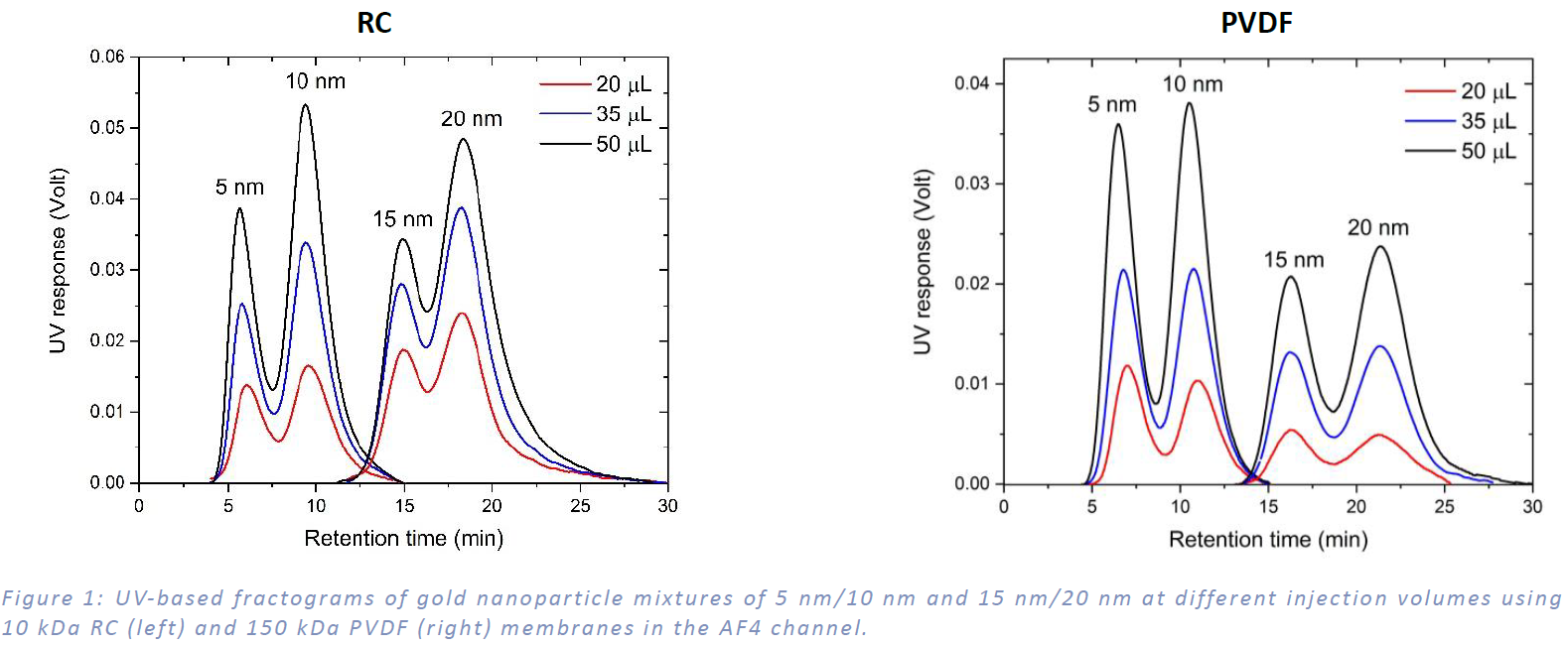Introduction
Asymmetrical Flow Field-Flow Fractionation (AF4) is a high-resolution separation technique that can fractionate particles from 1 nm up to few tens of microns in diameter. One important parameter that can affect separation efficiency and sample recovery in AF4 is the type of semi-permeable membrane that covers the accumulation wall of the AF4 channel. The membrane prevents the sample from exiting the channel via the crossflow outlet. It is permeable for the carrier liquid but not for the sample [1].
For the selection of the right membrane several factors have to be considered like the compatibility between the carrier liquid and the membrane, sample recovery, membrane cutoff, flux and surface flatness [1]. Attractive interactions between the membrane and the sample should be minimized as it can result in lower recovery rates or even in a loss of sample material and may thus negatively affect repeatability and reproducibility of retention times. For example, the Zeta potential of sample and membrane, particle density and attractive van der Waals forces can contribute to sample membrane interactions and have to be taken into account when choosing the right setup [2, 3].
Different membrane types and cutoffs are available commercially at Postnova which help users to choose the best membrane for their specific applications. In Table 1 the most common membranes are listed. For detailed and comprehensive information please contact Postnova.

In this application note, the effect of membrane type on resolution and sample recovery of gold nanoparticles (AuNPs) in AF4 is investigated.
Experimental
Four different sizes of AuNPs (from British BioCell International) were combined to create two polydisperse mixtures: (1) 5 nm and 10 nm; (2) 15 nm and 20 nm. The total gold concentrations of the mixtures were 20 ppm. To separate by size and characterize the AuNPs, an AF4 system (Postnova AF2000) was used with an in-line UV/Vis detector. An AF4 carrier liquid of nanopure water with a pH adjusted to 8 was used in the experiments. To investigate the effect of membrane on this separation, the experiment was performed twice, with both hydrophilic regenerated cellulose (RC) and hydrophobic polyvinylidenefluoride (PVDF) membranes with cutoffs of 10 kDa and 150 kDa respectively. Three different injection volumes (20 μL, 36 μL and 50 μL) were used for each experiment. The mixtures were analyzed with an initial crossflow rate of 2.5 mL/min which decayed linearly to a final crossflow rate of 0.15 mL/min in 14 min. The channel flow was 1 mL/min. The sample was injected with an injection flow rate of 0.2 mL/min and relaxed for 3 minutes prior to the elution step. Data was evaluated with the NovaAnalysis software.
Results
Figure 1 illustrates the UV-based fractograms of 5 nm and 10 nm, and 15 nm and 20 nm AuNP mixtures obtained by AF4 at three injection volumes using RC and PVDF membranes. Each NP is well-resolved from the others in the mixtures. The peak area scales well as injection volume increases, as the recorded UV/Vis detector signal, sensitive to particle concentration, shows.

The resolution can be calculated from retention time and peak width using the NovaAnalysis software. The results, listed in Table 2, show a slightly higher resolution for the PVDF membrane than for the RC membrane.
Both membranes show a similar peak area for the smallest, the 5 nm gold sample. This indicates that both membranes have similar recovery there. However, for the bigger particles the peak areas and the respective recovery rates on the PVDF membrane are significantly lower than on the RC membrane. Table 2 summarizes the peak area and the recovery rates for both AuNP mixtures for the different membranes.

Conclusion
The effect of the membrane type was investigated in AF4 separation of gold nanoparticles in the size range of 5-20 nm. Both hydrophobic and hydrophilic membranes showed similar resolution. However, the recovery rate differed with lower values for the PVDF membrane, showing also a size selectivity for the nanoparticle separation there. This demonstrates that specific care has to be taken to choose the membrane type as different membranes will exhibit different sample recovery.
References
1] M. E. Schimpf, K. Caldwell, J. C. Giddings, “Field-Flow Fractionation Handbook”, John Wiley & Sons, Inc., 2000.
[2] N. Bendixen, S. Losert, C. Adlhart, M. Lattuada, A. Ulrich, “Membrane-particle interactions in an asymmetric flow field flow fractionation channel studied with titanium dioxide nanoparticles”, Journal of Chromatography A, 2014, 1334, 92-100.
[3] J. Gigault, V. A. Hackley, “Size-independent effects on nanoparticle retention behavior in asymmetric flow field-flow fractionation”, Analytical and Bioanalytical Chemistry, 2013, 405, 6251-6258.
[4] ISO 21362 - Nanotechnologies — Analysis of nano-objects using asymmetrical flow and centrifugal field-flow fractionation.

